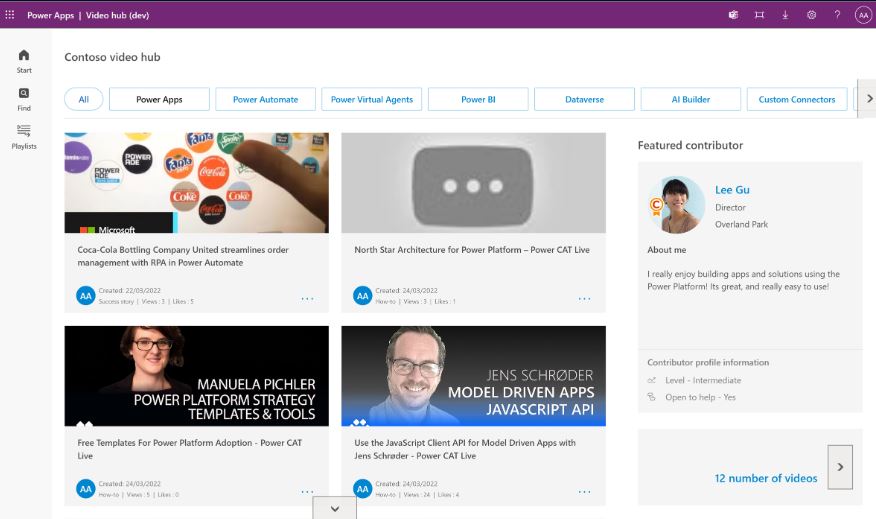Overview
A Center of Excellent (CoE) can be described as a competency or capability center run by a group of experts in the CoE’s focus area. The CoE is usually built around critical processes, technologies, or applications to help the company adopt a particular process and eventually become more efficient. The Microsoft Power Platform CoE Starter Kit is a set of resources, templates, and best practices created by Microsoft to help organizations establish a Center of Excellence (COE) for Power Platform. The COE Starter Kit is designed to help organizations develop a governance model and implementation strategy to ensure that their Power Platform solutions are reliable, secure, and compliant with organizational policies and industry standards.
The CoE Starter Kit includes templates and guidance for developing a COE charter, establishing governance standards, creating a solution design and development framework, and providing training and support for Power Platform users within the organization. By using the COE Starter Kit, organizations can accelerate their adoption of Power Platform and maximize the value of their investment in the technology.
COE Starter Kit have three main building blocks are:
- Core Component (Admin)
- Governance Components
- Nurture Components
Core Components (Admin):
The Core components (Admin) in the Power Platform Center of Excellence (CoE) starter kit is designed to provide an organized and efficient approach to managing the Power Platform environment within an organization.
The Admin component includes various tools and resources that enable administrators to monitor and manage the Power Platform environment. Some of the key features of the Admin component are:
Dashboard
The Admin Dashboard provides an overview of the Power Platform environment, including usage metrics, Power Automate flows, audit logs, and compliance status. It helps administrators identify areas that require attention and track the progress of ongoing initiatives.

Environment management
The Admin component provides tools for managing the various environments within the Power Platform, including creating and deleting environments, setting up sandbox environments, and managing environment permissions.
Notifications and alerts
The Admin component includes mechanisms for setting up notifications and alerts for various events, such as the creation of new apps or the deletion of sensitive data. This helps ensure that administrators are promptly informed of important events within the Power Platform environment
They sync all your resources into tables and build admin apps on top of that to help you get more visibility of the apps, flows, and makers that exist in your environment. Additionally, apps like DLP Editor and Set App Permissions help with daily admin tasks.
Governance Components:
The Governance component in the CoE (Center of Excellence) Starter Kit for Power Platform is designed to provide guidelines and best practices for managing the Power Platform environment within an organization. This component is essential for ensuring that the Power Platform is used in a consistent, secure, and compliant manner.
The Governance component includes the following key elements:
Sample Audit Process
This app is used in the auditing process as a tool for users to check whether their app, flow, chatbot or custom connector is compliant, and to submit information to the CoE admins as business justification to stay in compliance. This app used for creating compliance details requests.

Monitoring and Reporting
This component outlines the processes for monitoring and reporting on the use of the Power Platform. This includes monitoring for compliance and security risks, as well as reporting on usage and adoption.
By implementing the Governance component in the CoE Starter Kit for Power Platform, organizations can ensure that the Power Platform is used in a consistent, secure, and compliant manner, which can help to reduce risks and increase the value of the platform for the organization.
Nurture Components:
An essential part of establishing a Center of Excellence (CoE) is nurturing your makers and an internal community. You’ll want to share best practices and templates, and onboard new makers.
Training and Education
The CoE Starter Kit provides resources for training and education on Power Platform topics, including video tutorials, documentation, and links to relevant Microsoft resources. The goal is to help users develop their skills and understanding of the Power Platform, which can increase adoption and improve solution quality.

User Groups and Communities
This component offers guidance on establishing user groups and communities to promote collaboration, knowledge sharing, and feedback. These groups can help users learn from one another and receive support from the CoE team.
Feedback and Improvement
This components includes mechanisms for collecting feedback from users, such as surveys and user groups. This feedback can be used to improve the CoE resources, training, and support services. Additionally, the CoE team can use the feedback to identify areas where users need additional training or support.
Overall, these nurture components are designed to support and enable Power Platform users, which can lead to improved solution quality, increased adoption, and greater user satisfaction.
Conclusion
Establishing a Microsoft Power Platform Center of Excellence (CoE) means investing in and nurturing organic growth while maintaining governance and control. A CoE is designed to drive innovation and improvement, and as a central function it can break down geographic and organizational silos. A CoE can be a powerful way for an organization to align around business goals rather than individual department metrics.
A key principle is to clarify why you’re setting up a CoE, what you aim to accomplish, and the key business outcomes you hope to achieve. Then get started, and learn and evolve along the way. For many, the CoE is the first step in fostering greater creativity and innovation across the organization by empowering business units to digitize and automate their business processes, while maintaining the necessary level of central oversight and governance.
Please share your kind feedback in the comments section. For any query, feel free to Contact us or email us on [email protected]




